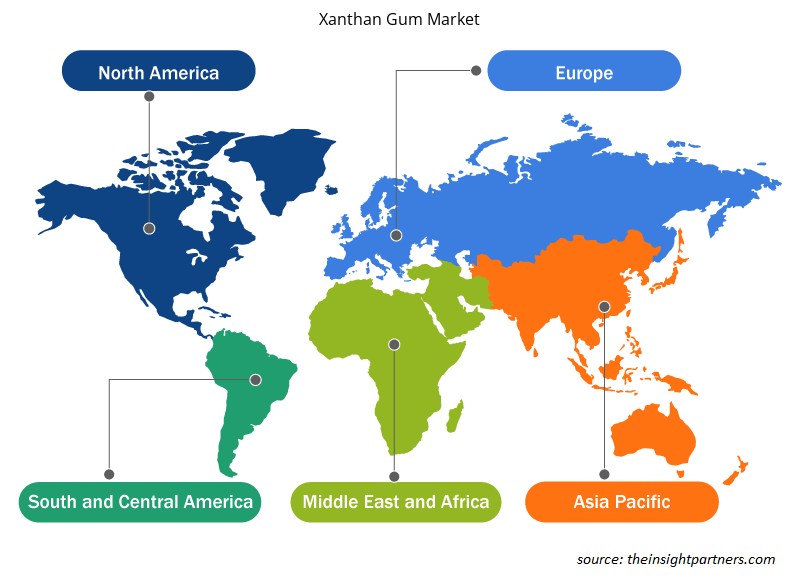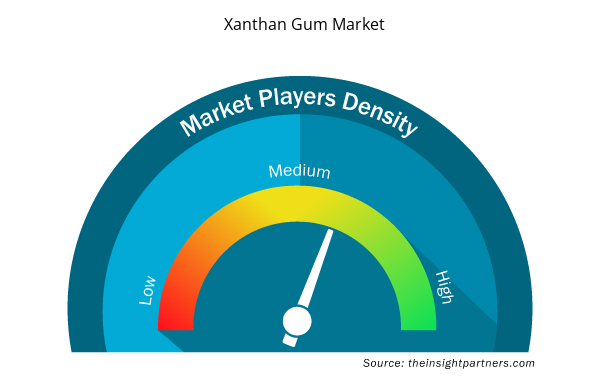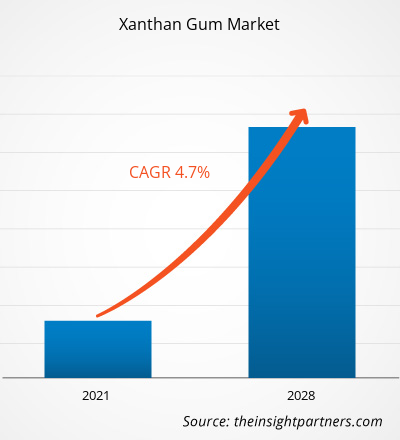[研究报告] 2020 年黄原胶市场价值为 5.7611 亿美元,预计到 2028 年将达到 8.2757 亿美元;预计 2021 年至 2028 年的复合年增长率为 4.7%。
黄原胶是一种多糖,用作食品和饮料、药品、个人护理产品等产品的添加剂。它是由细菌黄单胞菌通过发酵过程合成的。糖发酵时会产生液体,加入酒精后会凝固。之后,对其进行冲洗、压制和干燥。它通常有两种形式——干的和液体的。黄原胶可增强流体的粘度。它用作不同类型食品和饮料的稳定剂和增稠剂,包括烘焙和糖果产品、饮料、酱汁和调味品、乳制品和冰淇淋。它还用作个人护理和药品的稳定剂和流变改性剂。此外,它还用作石油钻探和开采过程中的流变改性剂。黄原胶在涂料和颜料行业也有各种应用。
2020 年,亚太地区占据了全球黄原胶市场的最大份额。由于印度、中国和日本等国食品和饮料加工厂数量的不断增加,中国和韩国个人护理和化妆品行业蓬勃发展,以及在油田应用领域的利用率不断提高,预计亚太地区黄原胶市场在预测期内将以显著的复合年增长率增长。此外,天然和加工食品和饮料消费量的不断增加,中国、印度、澳大利亚、马来西亚和越南等国对烘焙和糖果产品的需求不断增加,以及消费者健康意识的不断增强,这些都可能在未来几年推动亚太地区的市场增长。由于健身趋势日益增长,无麸质烘焙产品在整个地区越来越受欢迎。
定制此报告以满足您的需求
您可以免费定制任何报告,包括本报告的部分内容、国家级分析、Excel 数据包,以及为初创企业和大学提供优惠和折扣
- 获取此报告的关键市场趋势。这个免费样品将包括数据分析,从市场趋势到估计和预测。
COVID-19 疫情对黄原胶市场的影响
由于长期封锁、国际贸易限制、制造部门停工、旅行禁令导致供应链瓦解、原材料短缺等,COVID-19 疫情严重影响了不同地区行业的销售和整体运营。北美、欧洲和亚太等主要地区的食品和饮料工厂关闭影响了全球供应链,并对各种食品和饮料成分的制造、交付计划和销售产生了负面影响。黄原胶是各种方便食品的关键成分之一,例如烘焙食品、冷冻食品、乳制品和即饮 (RTD) 饮料。封锁期间,由于舒适食品的销量下降,黄原胶制造商的需求量较低。此外,COVID-19 危机在 2020 年上半年对全球美容行业产生了不利影响。这阻碍了个人护理行业对黄原胶的需求。然而,随着不同国家先前实施的限制措施的放松,企业正在加快步伐。此外,在政府和企业的支持下,疫苗接种速度加快,也进一步缓解了工商部门的困难局面。
市场洞察
无麸质食品需求上升
黄原胶是一种常见的食品添加剂,可用作麸质替代品。麸质是一种蛋白质,赋予小麦粉结构。黄原胶通常与不含麸质的面粉一起使用,以生产具有良好结构和质地的无麸质产品。FDA 和 USDA 监管标准限制了食品中的麸质含量。例如,根据 FDA 的无麸质食品标签规则,在标有“无麸质”、“无麸质”、“无麸质”或“无麸质”的产品中,麸质的允许限量低于百万分之二十。此外,黄原胶是一种重要的无麸质烘焙成分,可帮助烘焙食品保持形状并产生弹性。在其常见应用中,包括蛋糕和煎饼、饼干、松饼、快餐面包、披萨面团、面包和沙拉酱,黄原胶经常用于制作披萨面团。黄原胶的营养价值(包括碳水化合物和纤维)也增加了它的可接受性。此外,黄原胶还用于无麸质产品,以改善质地和保质期。与麸质一样,它也能保持烘焙食品的湿润和柔软。然而,占小麦、大麦和黑麦蛋白约 75% 的麸质会导致严重的肠道损伤,并增加乳糜泻患者发生心血管事件的风险。因此,麸质不耐症问题和其他由麸质引起的健康问题日益普遍,凸显了对无麸质产品的需求。
表单洞察
根据形式,黄原胶市场分为干黄原胶和液体黄原胶。干黄原胶在 2020 年占据了较大的市场份额,而液体黄原胶预计在预测期内将在市场上实现更高的复合年增长率。干黄原胶与任何液体混合时分散迅速,形成粘稠、稳定的溶液。因此,它是一种极好的增稠、悬浮和稳定成分。此外,黄原胶粉可用于液体中以提高其粘度、水合性和透明度。干黄原胶可溶于热液体和冷液体中。
应用程序洞察
根据应用,黄原胶市场细分为食品和饮料、药品和营养品、个人护理、石油和天然气等。食品和饮料部门在 2020 年占据了最大的市场份额,预计药品和营养品部门在预测期内将在市场上实现最高的复合年增长率。除了稳定的增稠特性外,黄原胶还有助于防止油分离,通过稳定调味品和酱汁等食品中的乳液。它被添加到冰淇淋和其他冷冻产品中以增强其质地。在烘焙和糖果产品中,黄原胶可作为保湿剂、质地增强剂和粘度增强剂。黄原胶是小麦粉的部分替代品,因为它充当粘合剂。在无麸质烘焙中使用时,黄原胶可为面团和混合物提供弹性和粘性。如果不使用黄原胶作为粘合剂,无麸质烘焙食品可能会失去其结构和质地。此外,为了获得更高的保质期,纤维素胶和黄原胶最常用作即饮饮料的稳定剂。黄原胶也是明胶的主要替代品之一,明胶来自动物。素食主义的兴起推动了食品和饮料行业对植物性食品成分的需求。
黄原胶市场的一些参与者包括 ADM、嘉吉公司、CP Kelco US, Inc.、中轩集团、阜丰集团、河北新和生化有限公司、Ingredion、梅花控股集团有限公司、Solvay SA 和联化集团。主要参与者专注于并购和研发等战略,以增加全球地理影响力和消费者基础。
报告亮点
- 黄原胶市场的渐进式行业趋势可帮助参与者制定有效的长期战略
- 发达市场和发展中市场采用的业务增长战略
- 2019 年至 2028 年黄原胶市场定量分析
- 全球黄原胶需求量估计
- 波特的五力分析说明了行业中买家和供应商的效力
- 了解竞争市场状况的最新发展
- 市场趋势和前景以及推动和抑制黄原胶市场增长的因素
- 通过强调支撑商业利益的市场策略来协助决策过程,从而促进市场增长
- 不同节点黄原胶市场规模
- 市场的详细概述和细分,以及黄原胶行业动态
- 各地区黄原胶市场规模及增长潜力
黄原胶市场区域洞察
Insight Partners 的分析师已详细解释了预测期内影响黄原胶市场的区域趋势和因素。本节还讨论了北美、欧洲、亚太地区、中东和非洲以及南美和中美洲的黄原胶市场细分和地理分布。

- 获取黄原胶市场的区域特定数据
黄原胶市场报告范围
| 报告属性 | 细节 |
|---|---|
| 2020 年市场规模 | 5.7611亿美元 |
| 2028 年市场规模 | 8.2757 亿美元 |
| 全球复合年增长率(2020 - 2028) | 4.7% |
| 史料 | 2018-2019 |
| 预测期 | 2021-2028 |
| 涵盖的领域 | 按形式
|
| 覆盖地区和国家 | 北美
|
| 市场领导者和主要公司简介 |
|
黄原胶市场参与者密度:了解其对业务动态的影响
黄原胶市场正在快速增长,这得益于终端用户需求的不断增长,而这些需求又源于消费者偏好的不断变化、技术进步以及对产品优势的认识不断提高等因素。随着需求的增加,企业正在扩大其产品范围,进行创新以满足消费者的需求,并利用新兴趋势,从而进一步推动市场增长。
市场参与者密度是指在特定市场或行业内运营的企业或公司的分布情况。它表明在给定市场空间中,相对于其规模或总市场价值,有多少竞争对手(市场参与者)存在。
在黄原胶市场运营的主要公司有:
- 阿彻丹尼尔斯米德兰公司
- 嘉吉公司
- 凯可
- 中轩
- 阜丰集团
免责声明:上面列出的公司没有按照任何特定顺序排列。

- 获取黄原胶市场顶级关键参与者概述
黄原胶市场 – 按形式
- 干燥
- 液体
黄原胶市场 – 按应用分类
- 食品和饮料
- 医药和保健品
- 个人护理
- 石油和天然气
- 其他的
公司简介
- 腺苷二磷酸
- 嘉吉公司
- 凯可
- 中轩
- 阜丰集团
- 河北信和生化有限公司
- 宜瑞安
- 梅花控股集团有限公司
- 索尔维公司
- 联化
- 历史分析(2 年)、基准年、预测(7 年)及复合年增长率
- PEST 和 SWOT 分析
- 市场规模价值/数量 - 全球、区域、国家
- 行业和竞争格局
- Excel 数据集



Report Coverage
Revenue forecast, Company Analysis, Industry landscape, Growth factors, and Trends

Segment Covered
This text is related
to segments covered.

Regional Scope
North America, Europe, Asia Pacific, Middle East & Africa, South & Central America

Country Scope
This text is related
to country scope.
Trends and growth analysis reports related to Food and Beverages : READ MORE..
The List of Companies - Xanthan Gum Market
- The Archer-Daniels-Midland Company
- Cargill, Incorporated
- CP Kelco
- Deosen
- Fufeng Group
- Hebei Xinhe Biochemical Co. Ltd.
- Ingredion
- Meihua Holdings Group Co. Ltd.
- Solvay S.A.
- Unionchem
The Insight Partners performs research in 4 major stages: Data Collection & Secondary Research, Primary Research, Data Analysis and Data Triangulation & Final Review.
- Data Collection and Secondary Research:
As a market research and consulting firm operating from a decade, we have published and advised several client across the globe. First step for any study will start with an assessment of currently available data and insights from existing reports. Further, historical and current market information is collected from Investor Presentations, Annual Reports, SEC Filings, etc., and other information related to company’s performance and market positioning are gathered from Paid Databases (Factiva, Hoovers, and Reuters) and various other publications available in public domain.
Several associations trade associates, technical forums, institutes, societies and organization are accessed to gain technical as well as market related insights through their publications such as research papers, blogs and press releases related to the studies are referred to get cues about the market. Further, white papers, journals, magazines, and other news articles published in last 3 years are scrutinized and analyzed to understand the current market trends.
- Primary Research:
The primarily interview analysis comprise of data obtained from industry participants interview and answers to survey questions gathered by in-house primary team.
For primary research, interviews are conducted with industry experts/CEOs/Marketing Managers/VPs/Subject Matter Experts from both demand and supply side to get a 360-degree view of the market. The primary team conducts several interviews based on the complexity of the markets to understand the various market trends and dynamics which makes research more credible and precise.
A typical research interview fulfils the following functions:
- Provides first-hand information on the market size, market trends, growth trends, competitive landscape, and outlook
- Validates and strengthens in-house secondary research findings
- Develops the analysis team’s expertise and market understanding
Primary research involves email interactions and telephone interviews for each market, category, segment, and sub-segment across geographies. The participants who typically take part in such a process include, but are not limited to:
- Industry participants: VPs, business development managers, market intelligence managers and national sales managers
- Outside experts: Valuation experts, research analysts and key opinion leaders specializing in the electronics and semiconductor industry.
Below is the breakup of our primary respondents by company, designation, and region:

Once we receive the confirmation from primary research sources or primary respondents, we finalize the base year market estimation and forecast the data as per the macroeconomic and microeconomic factors assessed during data collection.
- Data Analysis:
Once data is validated through both secondary as well as primary respondents, we finalize the market estimations by hypothesis formulation and factor analysis at regional and country level.
- Macro-Economic Factor Analysis:
We analyse macroeconomic indicators such the gross domestic product (GDP), increase in the demand for goods and services across industries, technological advancement, regional economic growth, governmental policies, the influence of COVID-19, PEST analysis, and other aspects. This analysis aids in setting benchmarks for various nations/regions and approximating market splits. Additionally, the general trend of the aforementioned components aid in determining the market's development possibilities.
- Country Level Data:
Various factors that are especially aligned to the country are taken into account to determine the market size for a certain area and country, including the presence of vendors, such as headquarters and offices, the country's GDP, demand patterns, and industry growth. To comprehend the market dynamics for the nation, a number of growth variables, inhibitors, application areas, and current market trends are researched. The aforementioned elements aid in determining the country's overall market's growth potential.
- Company Profile:
The “Table of Contents” is formulated by listing and analyzing more than 25 - 30 companies operating in the market ecosystem across geographies. However, we profile only 10 companies as a standard practice in our syndicate reports. These 10 companies comprise leading, emerging, and regional players. Nonetheless, our analysis is not restricted to the 10 listed companies, we also analyze other companies present in the market to develop a holistic view and understand the prevailing trends. The “Company Profiles” section in the report covers key facts, business description, products & services, financial information, SWOT analysis, and key developments. The financial information presented is extracted from the annual reports and official documents of the publicly listed companies. Upon collecting the information for the sections of respective companies, we verify them via various primary sources and then compile the data in respective company profiles. The company level information helps us in deriving the base number as well as in forecasting the market size.
- Developing Base Number:
Aggregation of sales statistics (2020-2022) and macro-economic factor, and other secondary and primary research insights are utilized to arrive at base number and related market shares for 2022. The data gaps are identified in this step and relevant market data is analyzed, collected from paid primary interviews or databases. On finalizing the base year market size, forecasts are developed on the basis of macro-economic, industry and market growth factors and company level analysis.
- Data Triangulation and Final Review:
The market findings and base year market size calculations are validated from supply as well as demand side. Demand side validations are based on macro-economic factor analysis and benchmarks for respective regions and countries. In case of supply side validations, revenues of major companies are estimated (in case not available) based on industry benchmark, approximate number of employees, product portfolio, and primary interviews revenues are gathered. Further revenue from target product/service segment is assessed to avoid overshooting of market statistics. In case of heavy deviations between supply and demand side values, all thes steps are repeated to achieve synchronization.
We follow an iterative model, wherein we share our research findings with Subject Matter Experts (SME’s) and Key Opinion Leaders (KOLs) until consensus view of the market is not formulated – this model negates any drastic deviation in the opinions of experts. Only validated and universally acceptable research findings are quoted in our reports.
We have important check points that we use to validate our research findings – which we call – data triangulation, where we validate the information, we generate from secondary sources with primary interviews and then we re-validate with our internal data bases and Subject matter experts. This comprehensive model enables us to deliver high quality, reliable data in shortest possible time.


 获取此报告的免费样本
获取此报告的免费样本